A week-long International Tour to Northern Greece and Lake Kerkini, organised together with our friends from Oriole Birding. It is a great destination for eastern migrants and south-eastern Mediterranean specialities. We had generally good weather with temperatures of 20-25C, nice birding conditions.
SUNDAY 28TH APRIL
Our plane departed on time and it was a smooth journey from Gatwick to Thessaloniki. Our first birds in Greece were the Jackdaws and House Sparrows around the airport terminal building, with several Tree Sparrows by the car hire office while we waited to do the paperwork for the minibus. It was just over an hour’s drive north to Lake Kerkini, but once we got out of the city we started to see a few more birds, with hirundines including our first Red-rumped Swallows, and raptors including Common Buzzard and Kestrel. The villages closer to the lake produced White Storks, with some on nests atop the telegraph posts.
When we got to the lake, we stopped on the southern embankment by the dam. Several Common Nightingales were singing in the bushes nearby, which was to be a constant soundtrack to the next few days, a Golden Oriole was fluting nearby and a Common Cuckoo was calling. An Eastern Olivaceous Warbler was chattering too, sounding a little like a Reed Warbler, and we eventually got a view of it skulking in the bushes.
There were several Grey Herons around the shore, and our first Squacco Heron of the trip flew in and landed by the rocks. A Great Cormorant was stretching its wings on a post and a Dalmatian Pelican flew in high over the dam. There were lots of gulls around the lake, mainly Yellow-legged Gulls of various ages, but we also found a single 2cy Caspian Gull out on the water, its distinctive snouty look, with a long, thin parallel-sided bill, giving its identity away. A group of Common Terns was gathered on the line of fishing net posts just offshore.
Scanning the surrounding hills, we picked up four birds circling high over the fields on the far side of the lake, Collared Pratincoles hawking for insects. They were distant at first but then turned and headed our way, flying high overhead and off to the south. Then our host, Stelios, turned up with our picnic lunch.
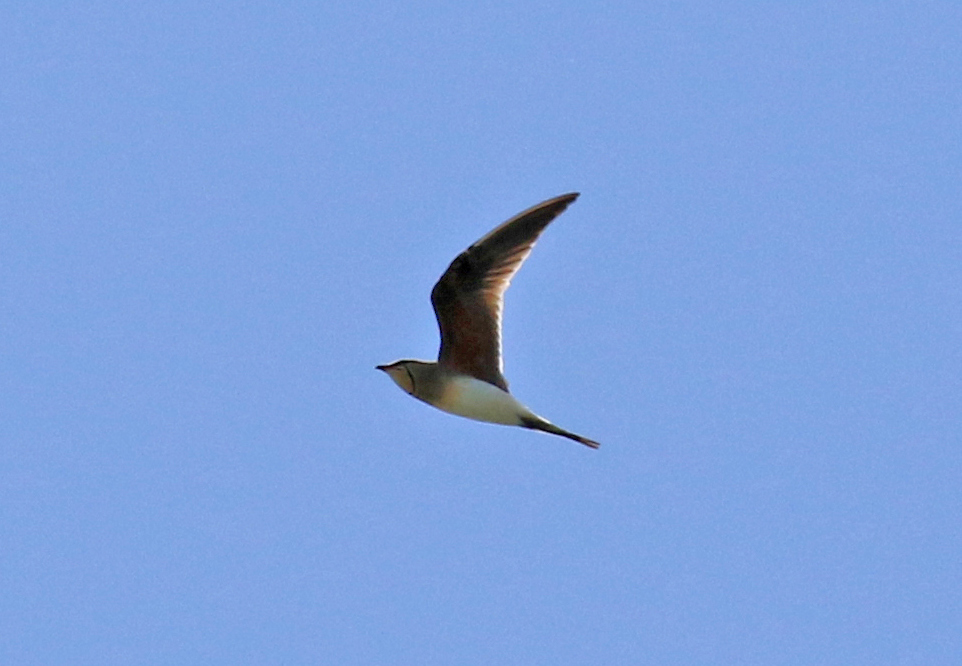
After lunch, we drove slowly up the western shore of the lake. Common Nightingales were singing everywhere in the scrub, and out into the more open cultivated areas, they were replaced by Corn Buntings. We stopped at Korifoudi, where a Crested Lark was feeding on a dusty track. A large flock of Western Yellow Wagtails was feeding around the feet of a herd of buffalo out on the short grass. They were mostly Black-headed Wagtails, we could hear their distinctive raspy calls, plus several Blue-headed Wagtails. As the buffalo came up to the road, the wagtails defected to a herd of cattle further back on the lake shore.
Two Woodchat Shrikes were perched out on the scattered bushes in the meadows and another two appeared by the road. We watched them chasing each other round in the bush, stopping to bob their heads in display. There were lots of Little Egrets along the lake shore and distantly out on the water beyond, we could see a huge feeding frenzy of cormorants and pelicans.
Scanning the surrounding hills, we picked up first a Booted Eagle circling high, and then a Black Stork drifting along the ridge. We heard Bee-eaters calling high overhead. There were several butterflies here too, including lots of Painted Ladys, several Clouded Yellows, and a smart Scarce Swallowtail feeding on some thistles by the road.
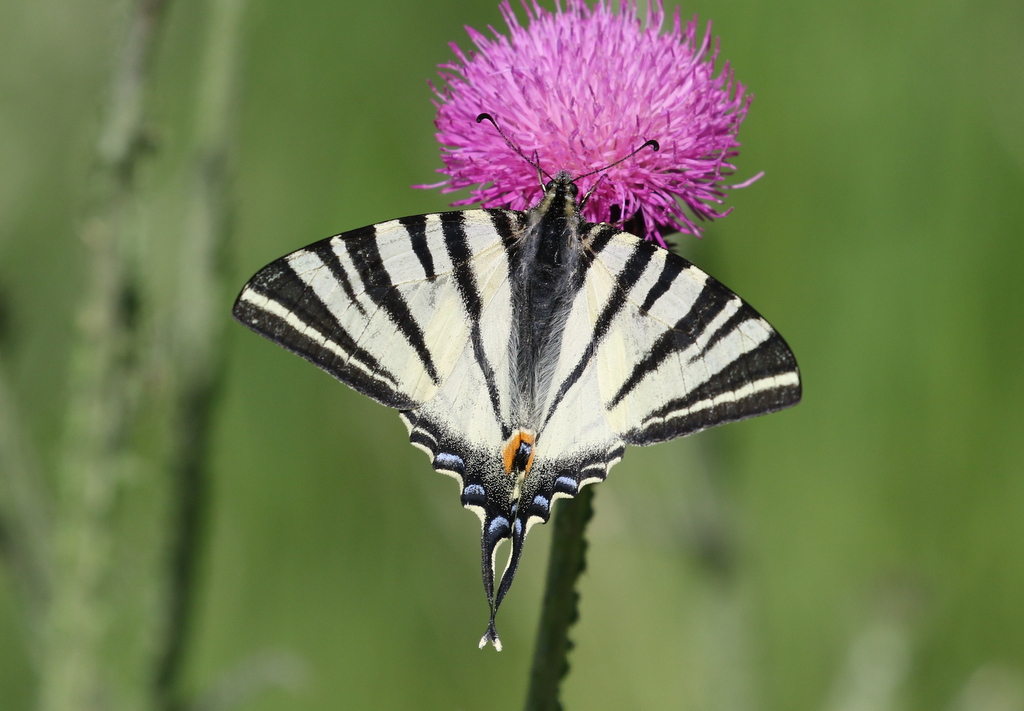
We tried to drive on, but there were lots of distractions – first we heard a Great Reed Warbler singing in a small clump of reeds, but it was keeping well down. Then a little further on, we spotted two Lesser Spotted Eagles down in the meadow next to the road, which flew up into the trees as we approached. We stopped to get them in the scopes. Another Great Reed Warbler was singing in some reeds nearby, but flew out as we walked over and headed over to another clump further back. Three Whinchats were out in the grass too.
We only managed to go another short distance before we stopped again to look at our first Pygmy Cormorant perched on a dead branch in the edge of the lake. A Wood Sandpiper was feeding in the shallows here, just below the road.

Eventually, we made it up to the hotel to check in. After a short break to settle in, we met again in the parking area where a Common Nightingale was singing (we would hear it here every day, usually in the same tree). There were also several Tree Sparrows here, and a Lesser Whitethroat rattling in a nearby garden which flew up into the top of a tree. A pair of Red-rumped Swallows and a pair of Pallid Swifts circled round overhead with the other hirundines.
We drove down to the harbour at Mandraki. The water here is quite shallow, particularly this year with the lake level lower than normal, and there were so many birds we didn’t know where to look first. There were herons everywhere, lots of Grey Herons and a huge number of Great White Egrets. A Purple Heron was tucked down in the grass on the edge of the lake, then six circled up together. A big group of Glossy Ibis was feeding actively further back in the shallow water, and when they flew up and came in past us we counted at least sixty. Squacco Herons were liberally scattered all around and six Black Storks circled up from the edge of the flooded forest
There were amazing numbers of Great Crested Grebes out on the water, with most paired up, and several pairs displaying. In amongst the weedy vegetation in the water, we found several Garganey and a single drake Ferruginous Duck: we could see its distinctive white iris. A few Greylag Geese required a closer look here, pink-billed birds of the eastern race rubirostris.
We could see lots of pelicans out on the nesting islands and around the edge of the lake further back. Beyond them, there was a good number of Greater Flamingoes. The flooded forest was chock full of cormorants, great and small (Pygmy!). Some small groups of pelicans were fishing closer to us, and we could see a few White Pelicans in with the Dalmatians. We finished watching some nice close Dalmatian Pelicans swimming just off the jetty in lovely evening light. Then we had to tear ourselves away to get back for dinner.
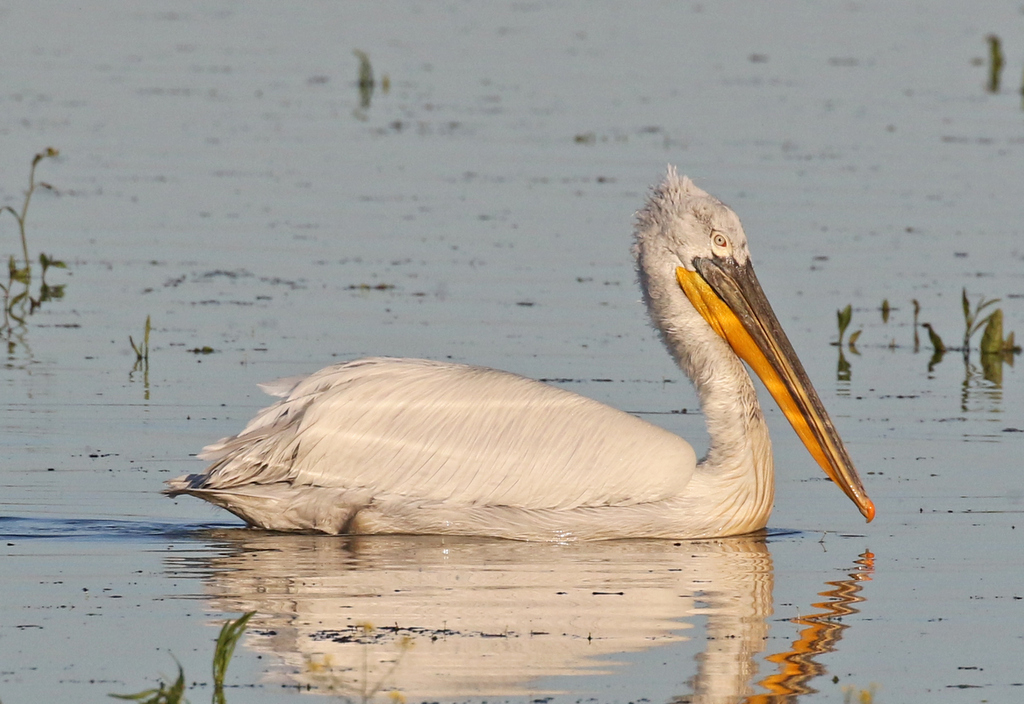
On the drive back, a Hoopoe was wrestling with a large worm by the road. Back at the hotel, the resident Scops Owl was singing briefly. It went quiet when we tried to look for it, but started up again later, once it got dark. It had been a great first day, but we were tired after an early start this morning, so after a delicious dinner, we turned in.
MONDAY 29TH APRIL
A quick early walk at dawn confirmed that a male Semi-collared Flycatcher was back on territory close to where we saw one last year, so after breakfast we all went up to see it. It was very active, flitting between the plane trees, singing all the time. It seemed to be prospecting nest holes in a couple of trees – we saw it go into one and it seemed to be returning to that branch repeatedly.
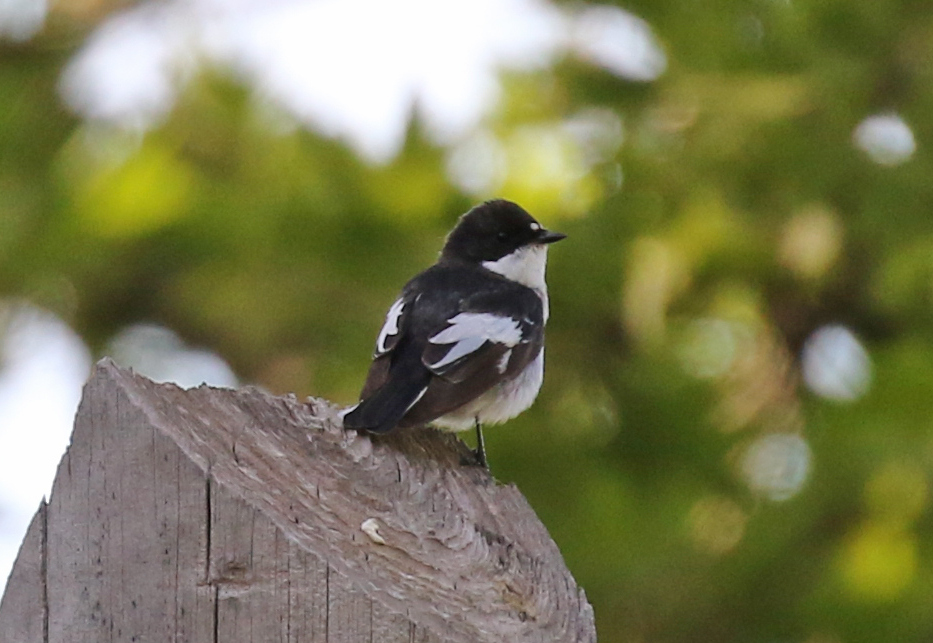
It was a young male with a rather restricted half collar and small double white patch over the bill, but with a large white patch at the base of the primaries and some barely visible white spots on the median coverts. It was good to see that at least one is back here again. Blackbird and Robin were also additions to the list there.
Afterwards, we headed out to one of our favourite spots, a bushy area by an overflowing water trough. It is a good area to see migrants when they are coming through but the bushes were quite quiet this morning. Perhaps birds were moving straight through and not stopping in the clear sunny weather, and some of the local breeding birds were clearly not arrived yet too. A pair of Golden Orioles perched briefly in the top of a distant dead tree and two Turtle Doves landed on the wires. A Woodchat Shrike and a Common Whitethroat were singing in the bushes and a Black Kite drifted over.
We continued on round to an area of woodland along the River Strimon floodplain. As we walked down the track, we were serenaded by Common Nightingales and lots of Marsh Frogs calling from the pools. It was starting to warm up quickly now and a Levant Sparrowhawk circled up, its rather pointed wings showing distinct blackish tips underneath, and a Lesser Spotted Eagle drifted over just above as we were watching it.
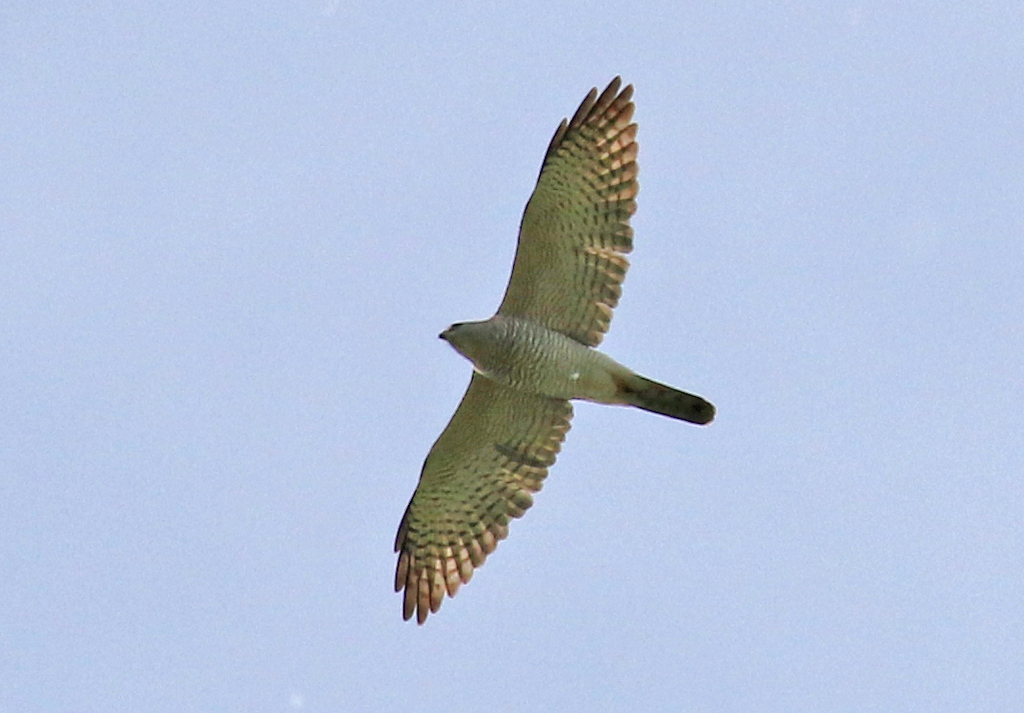
The woodpeckers were rather quiet today, probably a combination of the heat of the day and the time of year. We did find a black-and-white woodpecker skulking in the bottom of a thick tree close to what appeared to be a fresh hole, but when it eventually showed itself it was a Great Spotted Woodpecker. Then a little further on, we flushed a Green Woodpecker from the bushes by the track. Two Hoopoes were calling and kept flying off ahead of us. Several Spotted Flycatchers were flitting about in the trees and having heard it calling, a grey male Cuckoo flew across over the open fields followed by a rusty-coloured ‘hepatic’ female, the first of several we would see today.
There were lots of butterflies out in the sunshine along the track or out in the grass. A rather tatty looking Southern Festoon was the highlight, but we also found a couple of Grizzled Skippers, plenty of Queen of Spain Fritillaries and Clouded Yellows, and a few Common Blues. There were dragonflies here too – lots of Scarce Chasers and one or two Hairy Dragonflies down by the water. A Grass Snake curled up on the edge of the path quickly slithered in to the undergrowth as we approached.
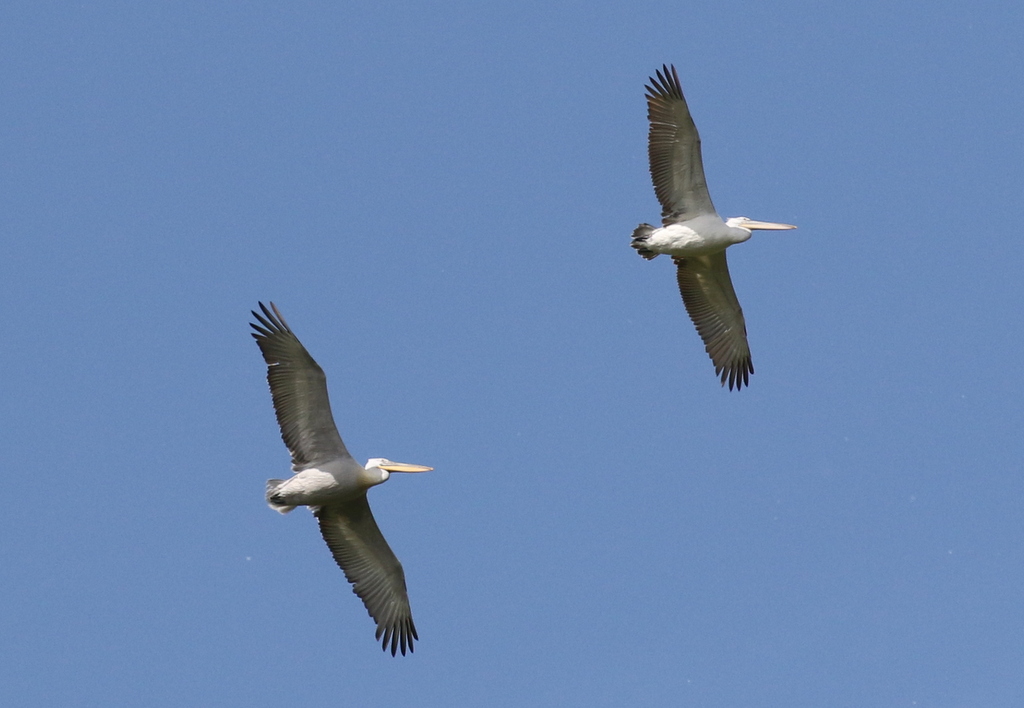
Small groups of pelicans starting to circle up over towards the lake, looking for thermals to give them lift, and four Dalmatian Pelicans drifted right overhead. Then a much bigger group of White Pelicans appeared further over, towards the river, with three Dalmatians in with them, allowing us to see their very different wing patterns. A few White Storks circled up too, and a Black Stork flew across just over the tops of the trees. A Long-legged Buzzard appeared briefly over the base of the hills to the north.
Our coffee stop this morning was taken by the River Strimon. A small group of Bee-eaters was perched on the wires and bushes beside the track opposite. Two Little Ringed Plovers and a Common Sandpiper were feeding on a sandy island in the middle of the river, along with a White Wagtail. Lots of House Martins were looking to nest under the bridge and several Sand Martins were coming and going from a sandy bank in the island the other side of the bridge. After coffee, we had a quick drive a short distance up the track opposite to try to photograph the Bee-eaters.
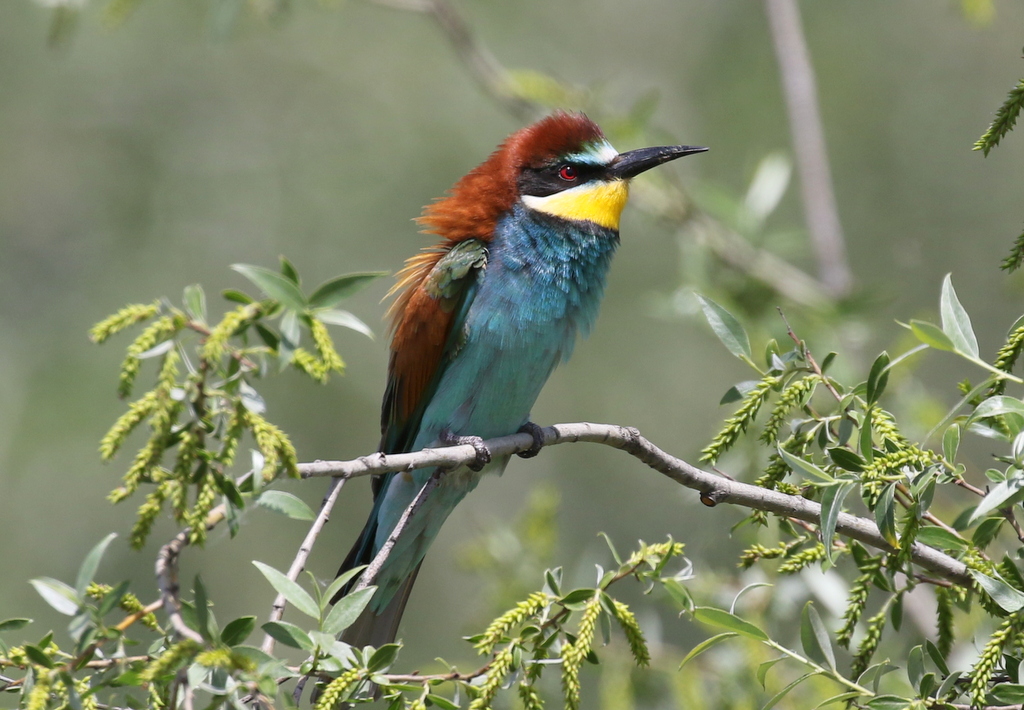
The rest of the day would be spent on the embankment which surrounds the eastern shore of the lake. There were lots of Moorhens on the first pool, along with several European Pond Terrapins and a Purple Heron walking along the opposite bank. There are several small clumps of reeds here and we stopped to scan them, almost immediately finding a female Little Bittern on the edge of one. As we scanned further across a female Little Crake was creeping in and out of the reeds nearby. The more we looked, the more we found – in the end, we counted at least six Little Crakes, five brown females and one slaty blue-grey male, and three female Little Bitterns.
A Dice Snake was curled up just in the reeds, a Coypu was half submerged in the water, and a pair of Little Grebes was busy diving. We could hear Penduline Tits calling from the willows and bushes on the other side of the bank, and we managed a brief view of a pair in the trees, chased off by a second male.
We were rather distracted by all the activity here and eventually retreated back to the nearby picnic area for a late lunch in the shade. There were Bee-eaters everywhere, calling all around us. After lunch, we continued on slowly down the embankment. On the next few pools, we found more Purple Herons and our first Spoonbill, plus a few Pygmy Cormorants. Several Turtle Doves were flying around between the bushes out on the grass beyond.
We stopped overlooking the northern edge of the lake. There were lots of Wood Sandpipers around the margins of the grassy islands, migrants stopping off on their way north, and a single Ruff was in with them. Several Black-winged Stilts were further back. A few Common Terns and three or four darker-bellied Whiskered Terns were hawking distantly over the water. There were lots of Black-headed Gulls loafing around the water’s edge, and a single Gull-billed Tern was in with them, preening. Through the scopes, we could see its distinctive short, thick black bill.
There are not so many ducks here in the spring, but as well as a smattering of Mallards, we did find three Common Pochard on the lake. A lone Ruddy Shelduck was over on the grass in front of the flooded forest, with three Greylag Geese nearby. What initially appeared to be a Black-headed Wagtail was feeding on the short grass just below the bank. On closer inspection, we could see it had a small trace of a white supercilium behind the eye, so it was actually a hybrid form of Yellow Wagtail, ‘superciliaris’.

Continuing on, Penduline Tits were calling all the way down the embankment but were mostly hidden in the vegetation. We pulled up at one likely looking area, where some poplar trees were overhanging a small area of reeds, and spotted a nest hanging down in amongst the leaves, suspended on one of the lower branches. Then a Penduline Tit appeared out of the reeds with a bill full of cobwebs and poplar seed, and flew up to the nest. We got out and through the scopes, we could see that the nest was an amazing structure, and quite well-built already. We watched the Penduline Tit weaving the gathered material into the structure, before it flew off back along the line of the ditch.
While we waited for it to return, a Lesser Spotted Woodpecker flew past and dropped down into the bushes below the bank where we could hear it calling. Eventually it flew back in and landed in a bush close to where we were standing, where we got a great look at it, a male with a bright red crown.

There were lots more Cuckoos along here and another hepatic phase female flew in and landed in the poplars above the Penduline Tit nest, where we could get a great view of it in the scope. A Kingfisher appeared down on the edge of the ditch too. Eventually the pair of Penduline Tits returned, and we watched them gathering material down in the reeds again, before flying up to add it to the nest.
On along the bank, there were several Golden Orioles fluting in the trees but they were difficult to see with all the leaves. Out in the middle of the lake, we could see a feeding frenzy of cormorants and pelicans. There were lots of Squacco Herons down on the rocky shore below the bank as we drove past and scanning the water’s edge we found a Spur-winged Lapwing too. We stopped to look at it, but it walked on behind some bushes, so we drove on a few yards and waited at the next gap in the vegetation. After a minute or two, it duly walked back into view. They are not so common here at the lake – we normally see them down on the coast – so this was a real bonus today.
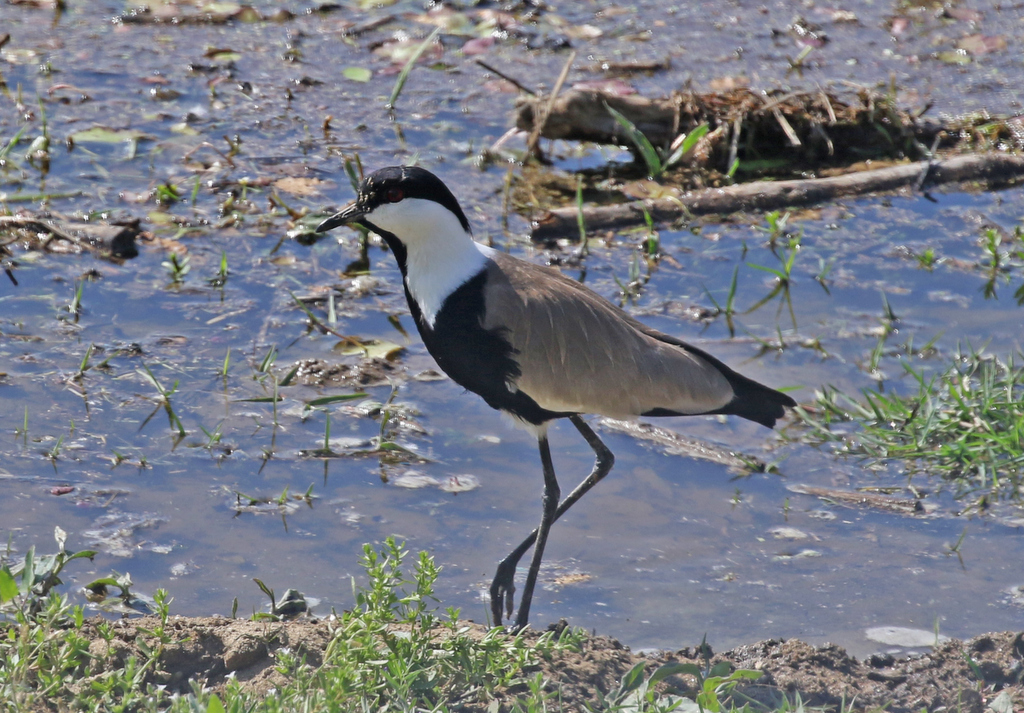
There were one or two Eastern Olivaceous Warblers singing in the bushes beside the bank as we passed, but not as many as we might normally expect to hear. They were obviously still arriving back for the breeding season. There were several Great Reed Warblers singing too – and we eventually got a better look at one perched up in the reeds. Then a Wildcat ran along the track on the bank ahead of us, before disappearing back into the vegetation.
The embankment was closed south of Limnochori, but we were planning to come off here anyway. It was time to be heading back. We had a quick stop in the village to admire a huge White Stork nest, and timed it perfectly as the adults changed over nest duties. One flew in and the other got up and flew off, landing on a nearby telegraph post which happened to be right above us. It stood there staring down. There were lots of sparrows going in and out of the base of the stork’s nest, mostly Spanish Sparrows, with one or two House and Tree Sparrows too. A pair of Red-rumped Swallows was flying in under the eaves of a nearby house.
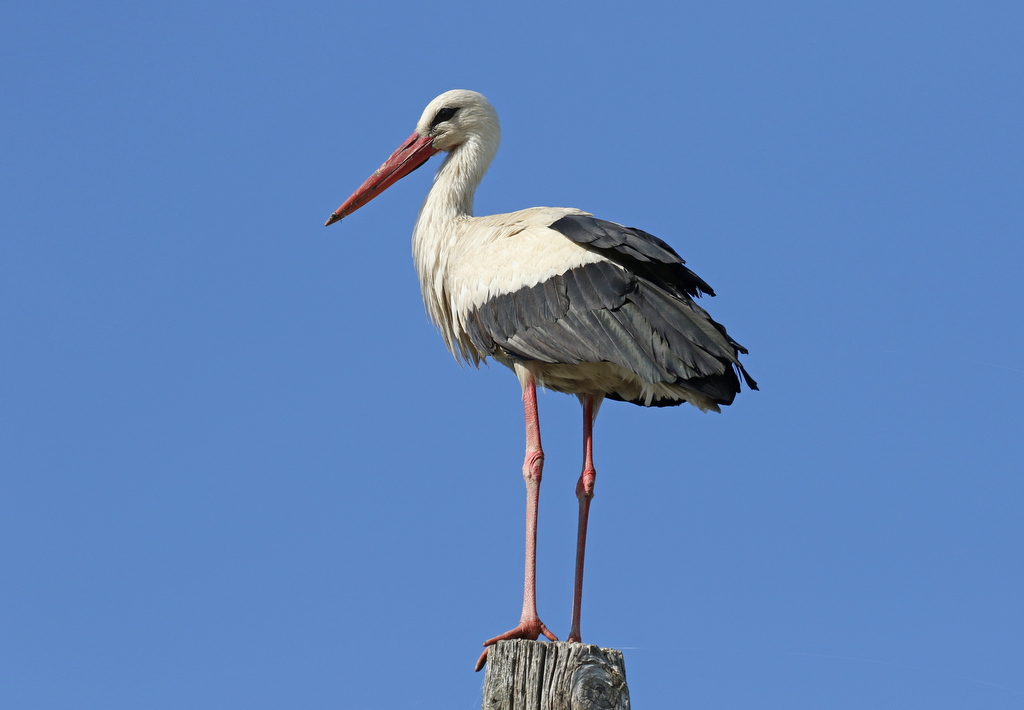
It had been another great day, but it was time to head back to the hotel for dinner. While we were still waiting for pudding, we heard a Scops Owl singing right outside. We went out, and realised we could actually hear two. One was in a tree above the road right in front of the hotel, so we tried to see if we could find it with a torch. It was too high up and there were too many leaves on the tree now, but we eventually saw it as it flew out.
TUESDAY 30TH APRIL
With a prompt getaway after breakfast, we headed up to the village of Promachonas in the hills on the Bulgarian border. We were looking for woodpeckers, and as soon as we walked in to the wood, a Middle Spotted Woodpecker flew over the track and landed in the trees next to us . We could see its red crown and pale red undertail. As we continued deeper into the wood – two more Middle Spotted Woodpeckers appeared in the top of a tree over the path, with one singing.
We stopped when we couldn’t go any further in. We could hear a Grey-headed Woodpecker, further off, over the other side of the river, but frustratingly it kept its distance. A Semi-collared Flycatcher was singing, and we found it flitting around in a tree a little further on down the path. There were also several Blackcaps singing in the trees, and a Nuthatch appeared to be feeding young, coming in repeatedly with food. A Red Squirrel scuttled up a trunk and a Kingfisher shot past through the trees.
As we walked back, a Great Spotted Woodpecker flew in over the path calling. It landed in a tree and chased off a Starling which seemed to be prospecting a hole. We tried another path through the wood, closer to the road, where a Golden Oriole was fluting. It was a bit more open here and there were several butterflies in the dappled shade, including a Southern Festoon and a couple of Dingy Skippers. Lots of Beautiful Demoiselle damselflies were down by the river.
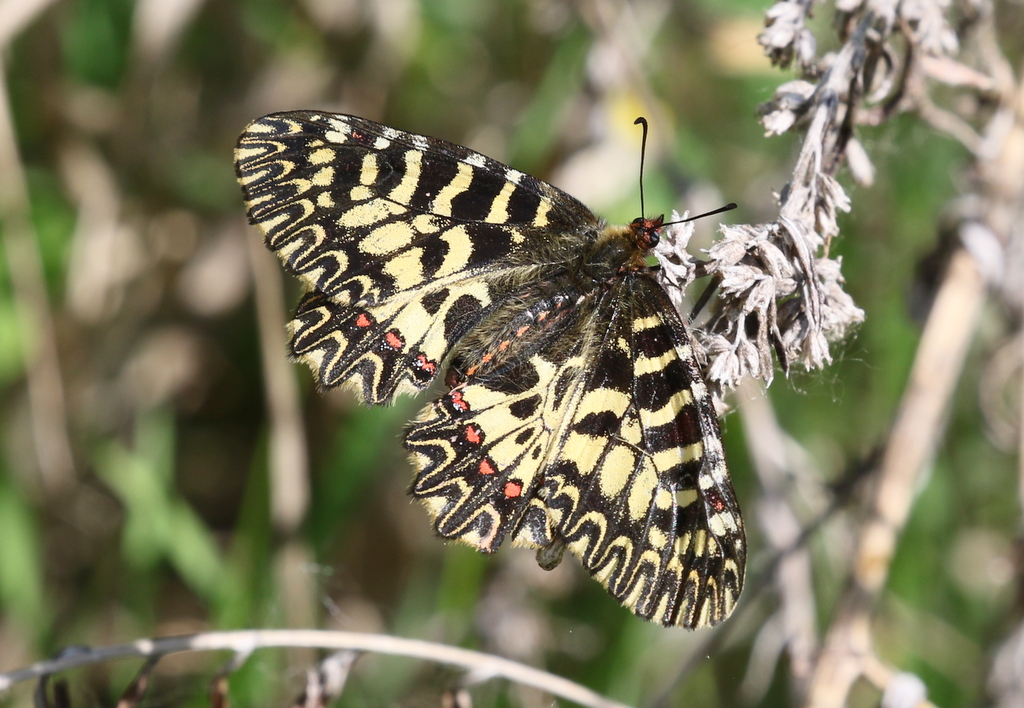
We had a very brief look for Masked Shrike in the quarry across the road, but there was no sign of any – perhaps they were late coming back this year? But we had run out of time, and had to get back down to the lake. Our boat trip had been organised for the afternoon, but with the forecast suggesting the wind might pick up it had been brought forward to 11am. We arrived back at the lake just in time.
As we motored out across the lake, there were lots of Great Crested Grebes on the water, and then out in the middle we found several much smaller Black-necked Grebes too. Close up, we could see their black necks and golden yellow face tufts. A flock of around twenty Collared Pratincoles flew over high.
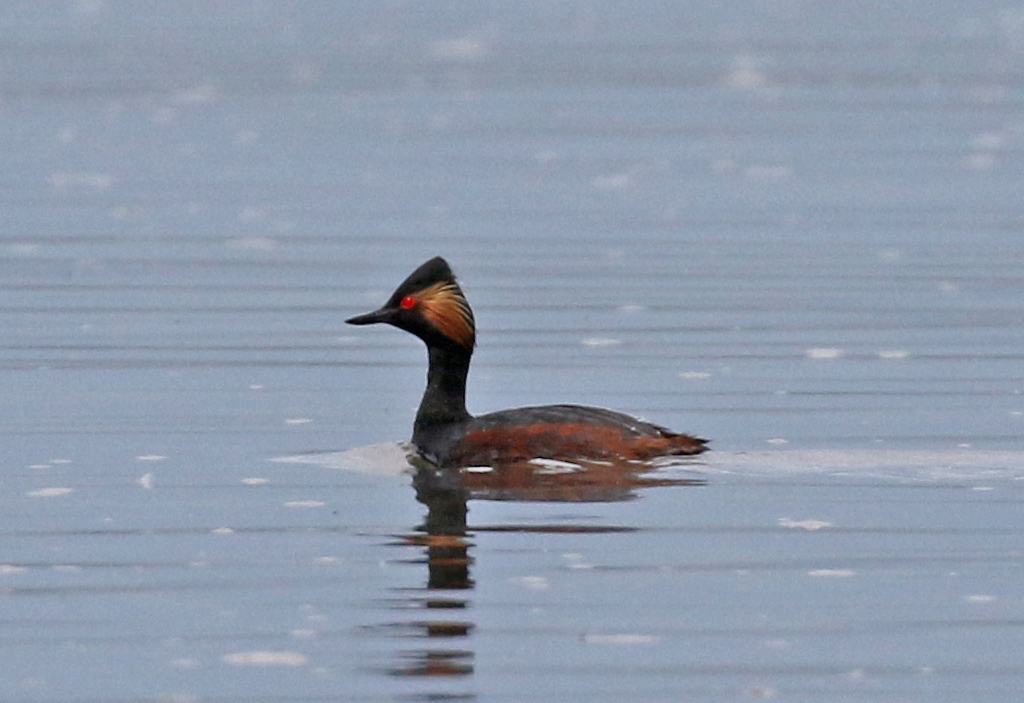
More birds were gathered around the mouth of the Strimon river, where it flows into the lake. A large flock of Greater Flamingoes put their heads up and started calling as we passed. We got some much better views of both Dalmatian and White Pelicans, with several of the latter still really pink (rather than white!).

There was a nice selection of lingering winter wildfowl out here, with a few Wigeon, Gadwall and Shoveler all additions to the trip list. A tight flock of about 20 Garganey flew round and four Ferruginous Ducks were swimming in the vegetation with a few Common Pochard. Several Common Shelduck were in amongst the legs of the Flamingoes, and the Ruddy Shelduck was out here too today.
Round at the flooded forest, the low water level this year was very noticeable, with lots of the trees on dry land. Thankfully we could still get through the edge of it in the boat and it was an amazing experience! The sight, the sound and the smell. Every tree was packed full of Great Cormorants on their nests, many with well grown young.

In amongst them were lots of herons. We had great close up views of Black-crowned Night Herons and Squacco Herons. A few Spoonbills were on their nests close to where we were, some with young already, and we could see many more further back in the trees or flying round overhead. There were just a few Pygmy Cormorants on the outer edge of the colony.
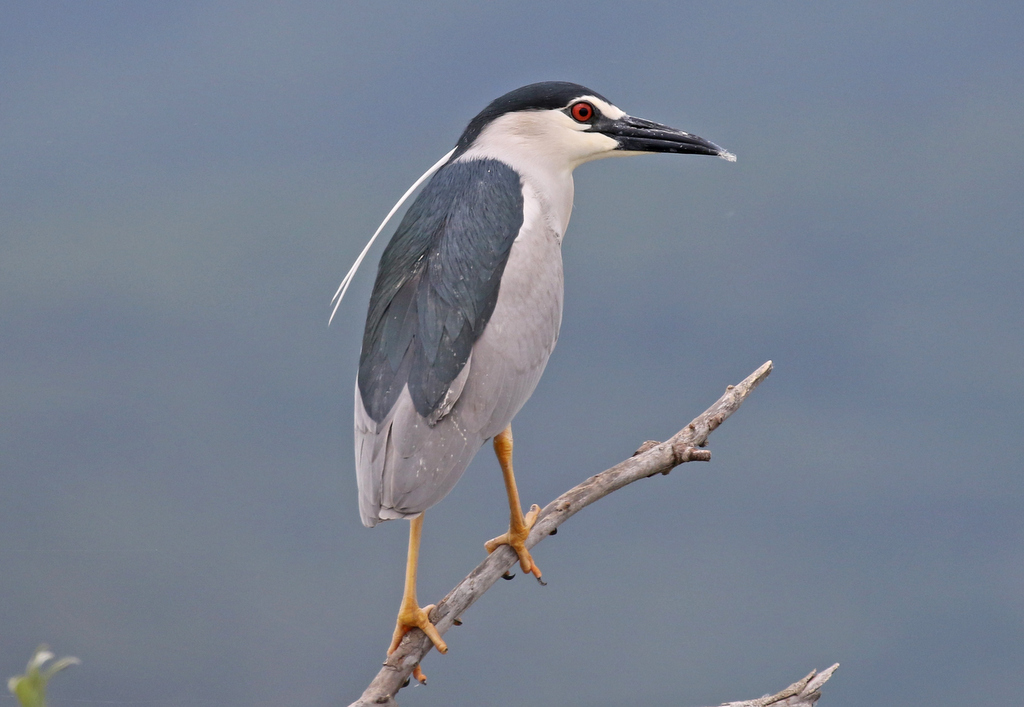
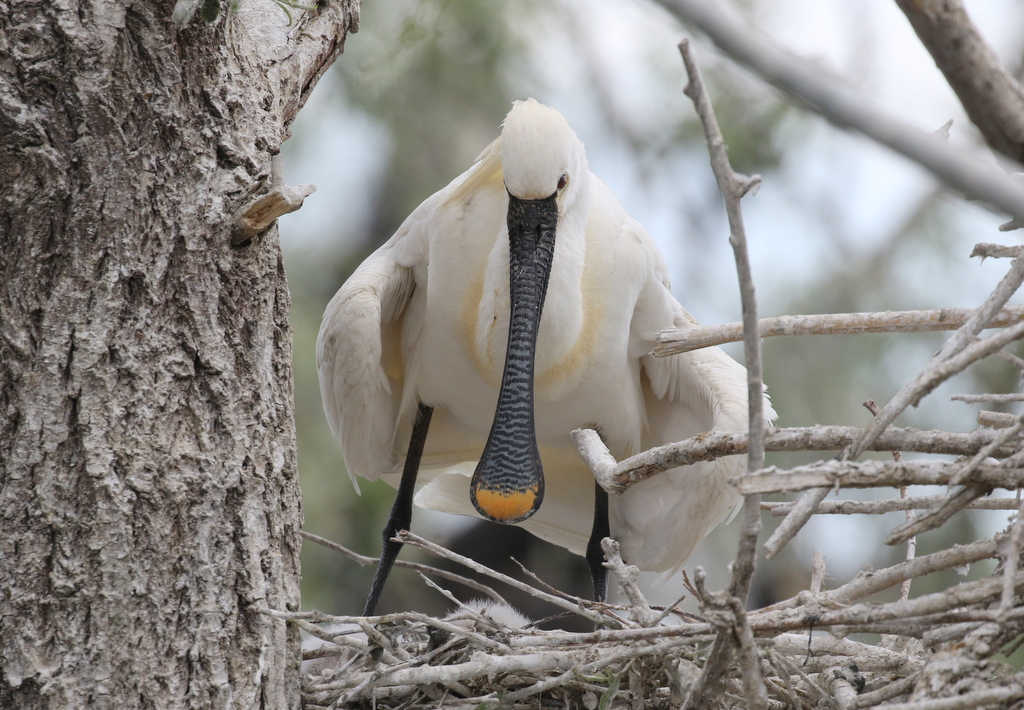
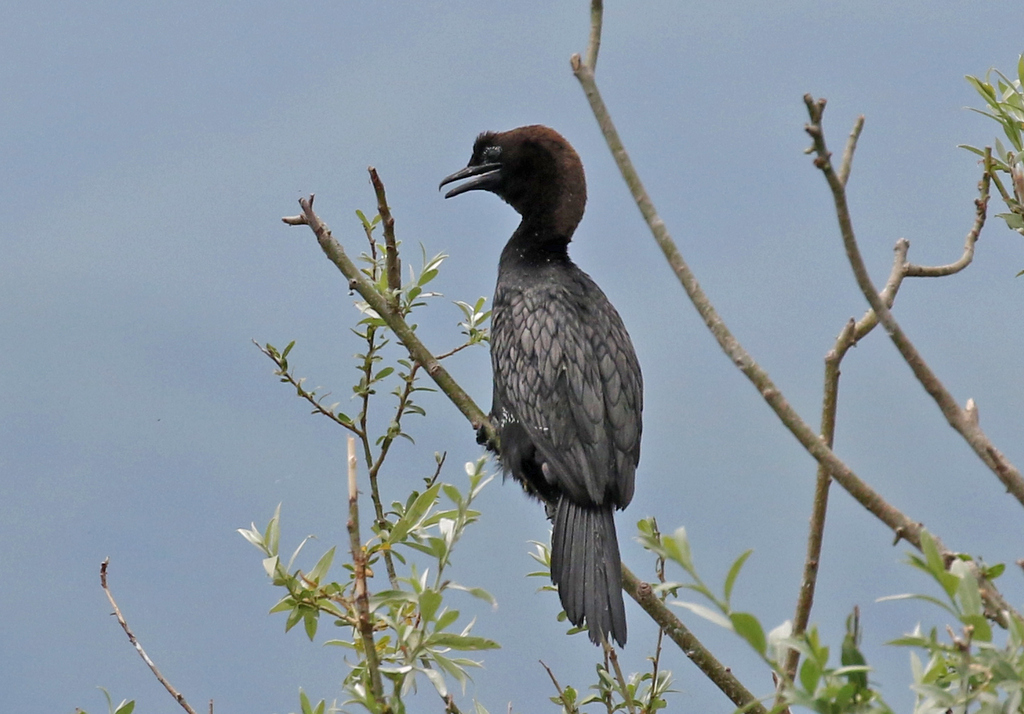
We went over to look at the pelican nesting islands. The older wooden platforms were packed with Dalmatian Pelicans, including several well-grown juveniles. The stone islands were more sparsely populated, with a mixture of Dalmatian and White Pelicans on the tops.
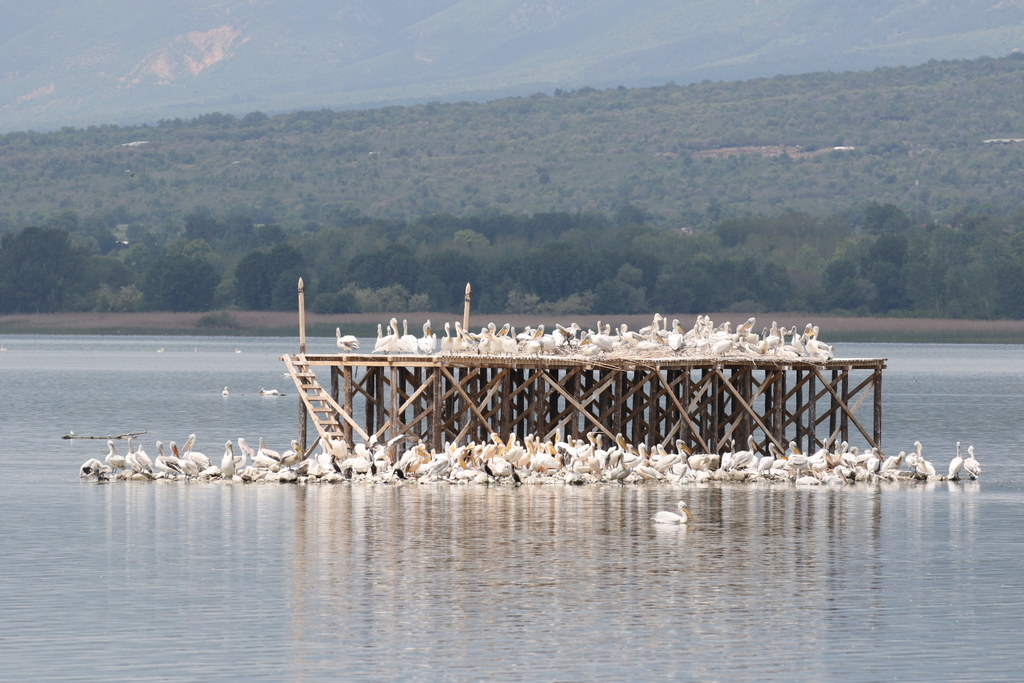
As we turned to head back, a lone Tufted Duck came up from the water. We hadn’t seen any marsh terns yet today, but as we motored back across the lake, we picked up a flock of around 20 way off in the distance. We headed over and could see them more clearly, before they helpfully came round for a really close pass, a mixture of 11 stunning breeding adult White-winged Black Terns and a smaller number of darker Black Terns, about 8. A great way to finish off the boat trip, which is always one of the highlights of any visit to Kerkini.

Back at the shore, it was time for lunch. We stopped just off the bank by a small poplar wood, where Golden Oriole and Green Woodpecker were calling in the trees. Several Spotted Flycatchers were flitting around in the bushes by the road and we could hear another Penduline Tit in the willows further back.
After lunch, we drove over to try the marshes by the River Strimon. A Little Ringed Plover flew up from the edge of the track as we passed and a Common Sandpiper was feeding down along the river shore. There were loads of Yellow-legged Gulls loafing on the gravel islands in the middle of the river, with one or two Caspian Gulls in with them. But as we got out to look at our first tortoise, a Spur-thighed Tortoise grazing on the grassy bank by the track, all the gulls flew up and whirled round. We had planned to walk out to marshes, but had a feeling they might be dry this year given the water levels. We met another group leaving who said they were indeed dry, so we decided to try something else instead.

















